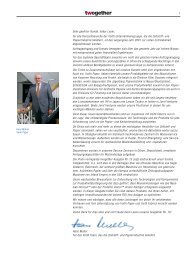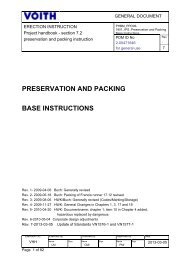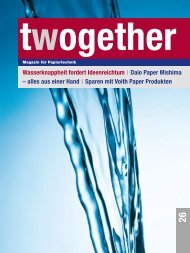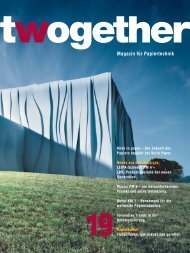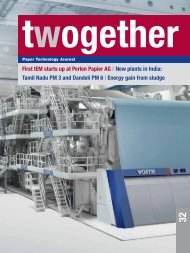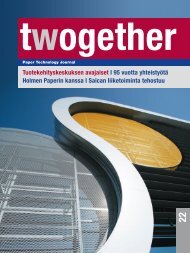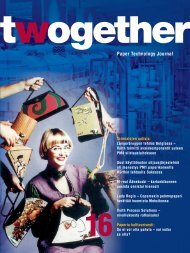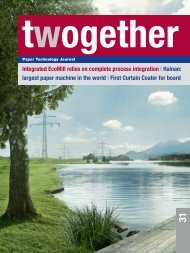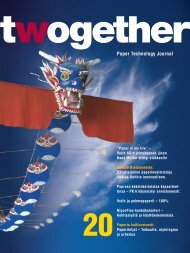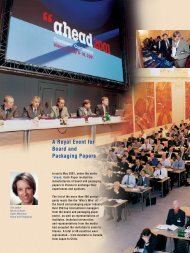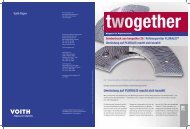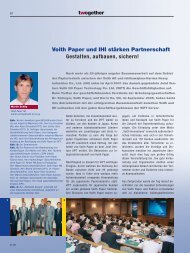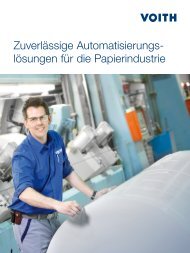Paper Technology Journal 19 - Voith
Paper Technology Journal 19 - Voith
Paper Technology Journal 19 - Voith
Create successful ePaper yourself
Turn your PDF publications into a flip-book with our unique Google optimized e-Paper software.
4 Stock buffer Water buffer Before<br />
optimization<br />
Dump chest 1000 m 3<br />
Total stock buffer DIP 1000 m 3<br />
Storage tower 1 DIP 800 m 3<br />
Storage tower 2 DIP 1000 m 3<br />
Dry broke 800 m 3<br />
Wet broke 800 m 3<br />
Total stock buffer PM 3600 m 3<br />
Buffer DIP<br />
ter was flowing from the paper machine<br />
loop into the biological effluent treatment<br />
plant compared with process water from<br />
the first stock preparation water loop.<br />
This indicated that the counterflow principle<br />
had not been properly implemented<br />
in the mill’s water management programme.<br />
With the counterflow principle, process<br />
water flows in the opposite direction to<br />
the stock flow. In other words, overflow<br />
from the paper machine water loop with a<br />
relatively low dissolved solids content is<br />
re-utilized in the stock preparation water<br />
loops before passing with a high dissolved<br />
solids content to effluent treatment.<br />
Total water buffer DIP<br />
Clear filtrate buffer 1<br />
Clear filtrate buffer 2<br />
Total water buffer PM<br />
–<br />
–<br />
1500 m 3<br />
–<br />
1500 m 3<br />
After<br />
optimization<br />
1000 m 3 (new)<br />
1000 m 3<br />
1500 m 3<br />
2000 m 3 (existing)<br />
3500 m 3<br />
The COD value (chemical oxygen demand)<br />
serves as a measure of colloidal<br />
and dissolved solids content (disturbing<br />
substances) in the various process water<br />
flows. In this mill case the COD test<br />
results clearly confirmed the balancing<br />
results (Fig. 3).<br />
In particular, the first water loop in the<br />
stock preparation line showed an unnecessarily<br />
high level of colloidal and dissolved<br />
solids due to the restricted operating<br />
mode (Fig. 2).<br />
Using a simulation model of the entire<br />
papermaking process, a proposal was<br />
worked out for a systematically optimized<br />
water management based on the counter-<br />
55<br />
Fig. 3: Simulated COD balance<br />
for conditions before optimization.<br />
The simulated balance indicated<br />
significant COD and disturbing<br />
substance improvements following<br />
implementation of the counterflow<br />
principle (see also Fig. 2).<br />
Fig. 4: Lack of dynamic water<br />
buffer capacities leads to uncontrolled<br />
overflows.<br />
flow principle. The relationship of dynamic<br />
stock and water buffer levels was also<br />
checked out and optimized (Fig. 4).<br />
Process analysis conclusions<br />
About one year after presenting the<br />
process analysis results, the success of<br />
all optimization measures taken so far<br />
has been confirmed. Some smaller, less<br />
spectacular measures still have to be taken.<br />
The process analysis has led to close<br />
teamwork between the mill and <strong>Voith</strong><br />
Process Solutions, so that all objectives<br />
are being reached in an economically<br />
sensible way.<br />
<strong>19</strong>/05



